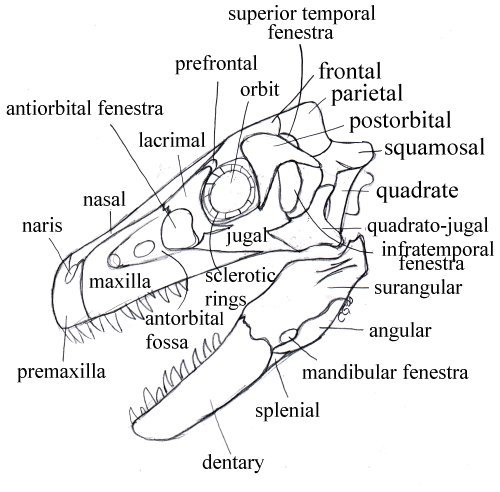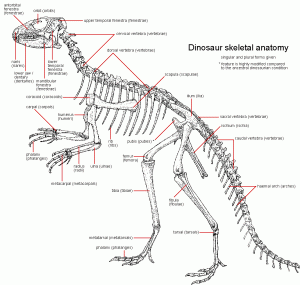Which direction to take!?
One of the most important things palaeontologists and taxonomists do is the description of new species or fossils. Focussing on dinosaurs, because they’re the ones I know the best, there is a whole host of descriptive anatomy to get your head around. It’s not just the names of the bones; it’s also the names of the parts and structures within bones, including muscle scars and hypothesised muscles that attached to them. As well as this, you have to describe the relative position and spatial relationships between these elements to build a 3-dimensional image of a fossil based on descriptive terminology. This final part comes with a host of orientation related terminology, and can be incredibly confusing to decipher. At request from Sam Barnett (@Palaeosam), here’s an attempt to break it down, so that whenever you’re reading a description of a new species, you’ll hopefully be able to figure out some of the position-related jargon scientists have used!
Note, that while these can refer also to specific parts of the body, they can be used as relative terms too (e.g., the scutes are positioned dorsally, and the scutes are dorsal to the vertebral column).
Anterior
This refers to the front end of an animal. Relatively, it means anything more towards the front; for example in a quadrupedal animal such as a horse or ornithischian dinosaur, the cervical (neck) vertebrae are anterior to the pelvis (the ilium, ischium, and pubis).
Posterior
This refers to the back of an animal (or the dorsal region if erect and bipedal). Relatively, and using the above example, the caudal (neck) vertebrae are posterior to the dorsal (back) vertebrae and the pectoral girdle (scapula, coracoid).
Caudal
This is similar to posterior, except helps more when talking particularly about the caudal vertebrae series. It doesn’t make much sense to say caudal 1 is more caudal than caudal 3 (or whatever you’re numbering system is), but it sounds much better to talk about them in relative terms of posteriority (i.e., caudal 1 is posterior to caudal 3, or the caudal chevrons thicken posteriorly).
Cranial
This has a similar usage to caudal, except regarding the skull (cranium). The dinosaur skull, as with most other vertebrates, is pretty complex, comprising a jigsaw of weirdly shaped bones. When discussing the relative positions of these, and the geometry of the bones themselves, cranial is not sufficient (e.g., cranial could mean any direction for a cheek bone (maxilla)). An example could be the deltopectoral crest on the humerus is directed cranially, or the dorsal vertebral series is cranial to the sacrum (pelvic bones and sacral vertebrae).
Dorsal
Anyone who knows marine animals will know this – where do you find the dorsal fin in fish? On the top! Dorsal can refer to something positioned on the top of an organism, or the side the backbone is on, such as the bony plates on Stegosaurus, or again denote a relative position (e.g., the ilium sits dorsally on the ilium and ischium, dorsally bounding the acetabulum).
Ventral
The anatomical opposite of dorsal; the lower part or surface of an organism or element. For example, the chevrons in a dinosaur tail will sit ventral to the vertebral column, or the fourth trochanter of the femur may be directed ventrally.
Proximal
These are a bit more useful as they can be used on multiple scales. It refers to the position relative to the ‘centre’, or attachment zone, of an organism – for example, the humerus is proximal in a forelimb, relative to the radius and ulna, and on the humerus, the deltopectoral crest will usually be proximally placed (i.e., in the upper half of the bone). It can be a little confusing when referring to elements in the main ‘trunk’ of an organism, so best to restrict to limb regions, or on an intra-element scale.
Distal
This is the opposite of proximal. The tibia and fibula are both distal to the femur, unless you’re some weird mutant thing. It can also be on an element-specific scale, for example, the lateral tendon pits are positioned distally on the lateral surfaces of the metatarsals.
Rostral
The rostrum is the snout (or muzzle). When referring to something being directed rostrally, it should typically be confined to the cranium (not part of the appendicular skeleton for example – this should be cranial or anterior); for example, the maxilla has a deep internal groove directed rostrally.
Medial
Refers to something directed inwardly towards the midline (sagittal plane) from the outside. This can be useful when describing the relative positions of all the complex parts of the skull, as well as the relative directions of many of the processes (sticky outy bits) of many of the limb bones and too (and skull bits); for example, the parietal has a strongly-developed and medially-directed process.
Lateral
This is a relative term again, and the opposite of medial; directed outwards from the inside (left or right of the sagittal plane). For example, the ischium curves gently laterally into an arcuate shape about a third of the way down the shaft.
Labial
This term refers to items specifically within the mouth, so, er, teeth. Teeth are surprisingly informative, and the detailed descriptions of their geometry and groove patterns are useful for taxonomy and phylogenetic assessments. Labial refers to a feature being directed towards the lips, or outside of the mouth. For example, the labial tooth surface is denticulate and covered in a fine coating of enamel.
Lingual
This refers to items within the mouth (so teeth again, usually) being directed inwards towards the tongue (or where you’d expect the tongue to be in fossil organisms). For example, the teeth have well-defined primary and secondary parallel ridges on the labial-facing surface.
Buccal
Within the mouth again, and referring to something facing or being directed cheekwards. For example, the teeth gently curve buccally (albeit, painfully).
Mesial
Final big mouth term, referring to something facing or pointing towards the middle of the jaw. For example, the posterior premaxillary process is mesially directed.
Longitudinal
Limb bones are quite asymmetrical, typically (look at your arm). The length, or axis, from the distal-most to the proximal-most ends, is referred to as the longitudinal axis. For example, the radius has a rugose patch on the medial surface and is longitudinally expanded.
Transverse
This refers to the plane that is orthogonal (perpendicular) to the longitudinal axis, or sagittal plane. For example, the ulna is twisted transversely about midway down the shaft.
Superior
I haven’t come across this one much in recent anatomical descriptions, but it refers to something located above, relatively positioned. For example, the superior process of the ischium is recurved medially.
Inferior
The opposite of superior, and again a relative term. Indicates something located below something else. For example, the inferior trochanters of the femur are laterally thickened.

To add another level of complexity, not all processes, grooves, attachment surfaces, weird bits of extrusive bone that you’ve got no idea is, are oriented along the same three orthogonal axes (i.e., cranial-caudal, dorsal-ventral, medial-lateral), so it’s perfectly normal to find crazy combinations of these, such as posterodorsal, anterolateral, medioventral etc. I’m not aware of any strict rules about which of these come first, I guess it’s just whichever sounds nicer? I hope this helps a bit – if you’d like to read a descriptive anatomy paper, I’m happy to send a paper that does a good job of this, or even my first Master’s thesis in which I describe a complete skeleton of Tenontosaurus tilletti, a pretty neat ornithopod dinosaur from the Early Cretaceous of Montana. Or something useful.
